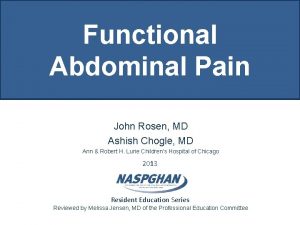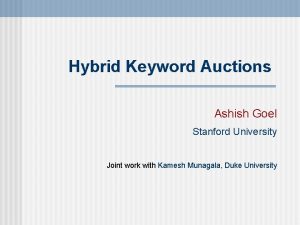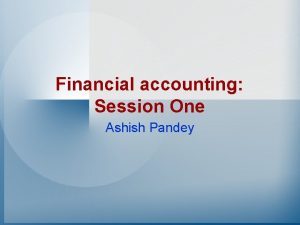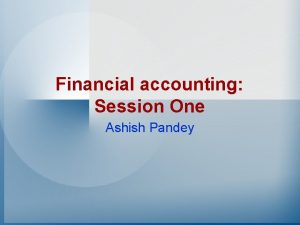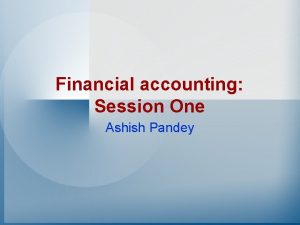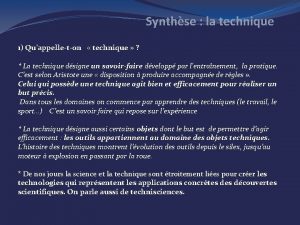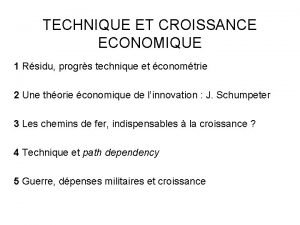Session 12 13 Ashish Pandey Technique no 4




























- Slides: 28

Session 12 & 13 Ashish Pandey

Technique no 4 Ratio analysis

Ratio Analysis Categories 1. 2. 3. 4. 5. 6. Profitability Resources Efficiency or Turnover Ratios Returns Liquidity Leverage/Solvency Capital Market Dupont analysis

Profitability ratios • Profitability measures look at how much profit the firm generates from sales • Measures degree of operating success of a company • Different measures of profit – – – Gross profit Cash operating profit (EBITDA) Operating profit (EBIT) PBTor EBT Net Profit or EAT

Various measures of profit Sales Less cost of goods sold Gross profit Less operating expenses EBITDA (Cash operating profit) Less non cash expenses (Depreciation & Amortisation) EBIT (Operating profit) Less Interest & finance charges PBT Taxes PAT (Net Profit)

Profitability Ratios Net profit margin Formula Net profit after taxes Net sales Gross profit margin Sales – Cost of goods sold Net sales Various measures of profit to sales Ratio of individual costs to sales Ratios of other income, extraordinary items, etc to sales How Expressed Meaning Percentage Shows how much after-tax profits are generated by each dollar of sales. Percentage Indicates the total margin available to cover other expenses beyond cost of goods sold, and still yield a profit.

Resources Efficiency or Turnover Ratios • Measures firm’s efficiency in utilising its assets/liabilities/capital

Resources Efficiency or Turnover Ratios Inventory turnover Days of inventory (LIQUIDITY) Net working capital turnover Formula How Expressed Meaning times Measures the number of times that average inventory of finished goods was turned over or sold during a period of time, usually a year. Days Average Inventory Cost of goods sold ÷ 365 Or 365/ITR Measures the number of one day’s worth of inventory that a company has on hand at any given time. Net sales or cogs Average Inventory times Measures how effectively the net working capital is used to generate sales. times Measures the utilization of all the company’s assets; measures how many sales are generated by each dollar of assets. Times Measures the utilization of the company’s fixed assets (i. e. , plant and equipment); measures how many sales are generated by each dollar of fixed assets. Net sales Net working capital Asset turnover Sales Average Total assets Fixed asset turnover Sales Fixed assets

Resources Efficiency or Turnover Ratios (con’t) Accounts receivable turnover Average collection period or days sales outstanding (LIQUIDITY) Accounts payable turnover Suppliers credit (LIQUIDITY) Formula How Expressed Meaning times Indicates the number of times that accounts receivable are cycled during the period (usually a year). Days Indicates the average length of time in days that a company must wait to collect a sale after making it; may be compared to the credit terms offered by the company to its customers. times Indicates the average length of time in days that the company takes to pay its credit purchases. days Indicates average credit period availed by a company from its suppliers Days Indicates the number of days of cash on hand, at present sales levels. Annual credit sales Average Accounts receivable Sales for year ÷ 365 Or 365/ART Annual credit purchases Average accounts payable Average Accounts payable Purchases for year ÷ 365 Or 365/APT Days of cash Cash Net sales for the year ÷ 365

Returns Ratios • Another variant of Profitability ratios, here the denominator is the amount invested. • Ultimate objective of the company management is to maximise ROI

Return on investment Ratios Formula Return on investment (ROI) How Expressed Meaning Percentage Measures the rate of return on the total assets utilized in the company; a measure of management’s efficiency, it shows the return on all the assets under its control regardless of source of financing. Percentage Measures the rate of return on the book value of shareholders’ total investment in the company. Percentage Measures the overall profitability after discharging cost of borrowed funds & taxes Net profit after taxes Long term investment Return on equity (ROE) ROE Earnings per share (EPS) CEPS Net profit after taxes- pref div Shareholders’ equity Net profit after taxes-pref div Shareholders’ equity+ Reserves & Surplus Net profit after taxes – Preferred Dollars per share stock dividends Average number of common shares PAT-PD+non cash charges Average number of common shares Shows the after-tax earnings generated for each share of common stock.

Liquidity Ratios • Ability of a business to meet its short-term obligations when they fall due.

Liquidity Ratios Formula Current ratio How Expressed times A short-term indicator of the company’s ability to pay its shortterm liabilities from short-term assets; how much of current assets are available to cover each dollar of current liabilities times Measures the company’s ability to pay off its short-term obligations from current assets, excluding inventories. times Measures the extent to which the company’s capital is in cash or cash equivalents; shows how much of the current obligations can be paid from cash or near-cash assets. Current assets (CA) Current liabilities (CL) Quick (acid-test) ratio CA – Inventory-Prepaid expenses Current liabilities Cash ratio Cash + Cash equivalents Current liabilities Receivable turnover Inventory turnover Operating cycle Meaning

Solvency/Leverage ratios • Extent of debt used to finance assets • Capacity of company to discharge its obligations towards long term lenders indicates its financial strength and ensures its long term survival

Leverage Ratios Formula Debt to asset ratio How Expressed Meaning Percentage Measures the extent to which borrowed funds have been used to finance the company’s assets. Percentage Measures the funds provided by creditors versus the funds provided by owners. Percentage Measures the long-term component of capital structure. times Indicates the ability of the company to meet its annual interest costs. times A measure of the company’s ability to meet all of its fixed charge obligations. Total debt Total assets Debt to equity ratio Long-term debt to capital structure Interest coverage Debt service coverage ratio Total debt Net worth Long-term debt Net worth Profit before taxes + Interest charges + non cash charges Interest charges + Instalments of Principal due

Valuation or Capital market standing • As the equity is traded in the stock market, the investors both current & prospective would be interested in assessing the performance of the stock in the market

Valuation or capital market Ratios Formula How Expressed Meaning Decimal Shows the current market’s evaluation of a stock, based on its earnings; shows how much the investor is willing to pay for each dollar of earnings. Percentage Indicates the percentage of profit that is paid out as dividends. Percentage Indicates the dividend rate of return to common shareholders at the current market price. EPS Price/earning ratio Market price per share Earnings per share Dividend payout ratio Annual dividends per share Annual earnings per share Dividend yield on common stock. Annual dividends per share Current market price per share

Du pont analysis It is a useful technique to break down the ROE into its constituent elements. It helps to understand the reasons for inc or dec in ROE by identifying the underlying variables ROE= net margin ratio X total assets turnover ratio X Financial leverage = PAT X Sales X total assets Sales total assets Shareholders funds

Earnings Quality

Earnings Quality • Earnings quality refers to the ability of reported earnings to predict a company’s future. The relevance of any historicalbased financial statement hinges on its predictive value.

For earnings to be of high quality it should possess the following features 1. Derived from core business operations 2. Recognised, measured and presented accordance with GAAPs 3. Principal qualitative characteristics adhered to 4. Accounting policies consistently followed 5. Close to reality i. e. neither overstated nor understated 6. High chances of continuation and sustenance of the past earnings And thus a fair prediction of future profitability and cash flows possible

Earnings Management

Earnings management • Earnings management is the use of accounting techniques to produce financial reports that may paint an overly positive picture of a company's business activities and financial position.

They may either • Increase income, increase assets, decrease liabilities – Raise estimated life of an asset – Lower the prov for DD – Recognise rev for goods sent but not sold – Shift from wac to fifo incase of inflation • Decrease income, decrease assets, increase liabilities

ANNUAL REPORT

Annual Report • An annual report is a comprehensive report on a company's activities throughout the preceding year. Annual reports are intended to give shareholders and other interested people information about the company's activities and financial performance.

Constituents of an annual report • • • Chairman’s letter Financial Highlights Letter to the Shareholders Narrative Text, Graphics and Photos Management's Discussion and Analysis Financial Statements Notes to Financial Statements Auditor's Report Directors report Corporate Governance report Summary Financial Data Corporate Information

Management Discussion and analysis 1. Discusses different aspects of the business. – – new hires or appointments, new product introductions, updates on the progress of business acquisitions, other information management believes to be important to investors. 2. overview of the previous year's developments and how the company performed over that period. 3. good starting point for a new investor who wants to understand a business' fundamentals.
 Ashish bajaj fms
Ashish bajaj fms Ashish ganguly imtech
Ashish ganguly imtech Naveen jonathan
Naveen jonathan Ashish chogle
Ashish chogle Dr ashish kumar bhutani
Dr ashish kumar bhutani Ashish jain microsoft
Ashish jain microsoft Ashish goel stanford
Ashish goel stanford Ashish motivala
Ashish motivala Ashish vaswani
Ashish vaswani Ashish kachru
Ashish kachru Ashish singh parihar
Ashish singh parihar Ashish tilethe
Ashish tilethe Binary translation in virtualization
Binary translation in virtualization Mannu singh vs umadat pande
Mannu singh vs umadat pande What is oosd
What is oosd Pc pandey iitb
Pc pandey iitb Kriti bhatia
Kriti bhatia Dr nitin pandey sms hospital
Dr nitin pandey sms hospital Pc pandey iitb
Pc pandey iitb Omkant pandey
Omkant pandey Ryan pandey
Ryan pandey Alok
Alok Ashok kumar pandey iith
Ashok kumar pandey iith Brahmi
Brahmi Sophia pandey
Sophia pandey .net 5 session
.net 5 session Php cookie
Php cookie Mainframe session manager
Mainframe session manager Cake session
Cake session



